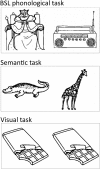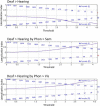How Auditory Experience Differentially Influences the Function of Left and Right Superior Temporal Cortices
- PMID: 28821674
- PMCID: PMC5618270
- DOI: 10.1523/JNEUROSCI.0846-17.2017
How Auditory Experience Differentially Influences the Function of Left and Right Superior Temporal Cortices
Abstract
To investigate how hearing status, sign language experience, and task demands influence functional responses in the human superior temporal cortices (STC) we collected fMRI data from deaf and hearing participants (male and female), who either acquired sign language early or late in life. Our stimuli in all tasks were pictures of objects. We varied the linguistic and visuospatial processing demands in three different tasks that involved decisions about (1) the sublexical (phonological) structure of the British Sign Language (BSL) signs for the objects, (2) the semantic category of the objects, and (3) the physical features of the objects.Neuroimaging data revealed that in participants who were deaf from birth, STC showed increased activation during visual processing tasks. Importantly, this differed across hemispheres. Right STC was consistently activated regardless of the task whereas left STC was sensitive to task demands. Significant activation was detected in the left STC only for the BSL phonological task. This task, we argue, placed greater demands on visuospatial processing than the other two tasks. In hearing signers, enhanced activation was absent in both left and right STC during all three tasks. Lateralization analyses demonstrated that the effect of deafness was more task-dependent in the left than the right STC whereas it was more task-independent in the right than the left STC. These findings indicate how the absence of auditory input from birth leads to dissociable and altered functions of left and right STC in deaf participants.SIGNIFICANCE STATEMENT Those born deaf can offer unique insights into neuroplasticity, in particular in regions of superior temporal cortex (STC) that primarily respond to auditory input in hearing people. Here we demonstrate that in those deaf from birth the left and the right STC have altered and dissociable functions. The right STC was activated regardless of demands on visual processing. In contrast, the left STC was sensitive to the demands of visuospatial processing. Furthermore, hearing signers, with the same sign language experience as the deaf participants, did not activate the STCs. Our data advance current understanding of neural plasticity by determining the differential effects that hearing status and task demands can have on left and right STC function.
Keywords: deaf; language; plasticity; sign language; superior temporal cortex; visuo-spatial working memory.
Copyright © 2017 Twomey et al.
Figures




Similar articles
-
Neural systems underlying British Sign Language and audio-visual English processing in native users.Brain. 2002 Jul;125(Pt 7):1583-93. doi: 10.1093/brain/awf153. Brain. 2002. PMID: 12077007 Clinical Trial.
-
The impact of early language exposure on the neural system supporting language in deaf and hearing adults.Neuroimage. 2020 Apr 1;209:116411. doi: 10.1016/j.neuroimage.2019.116411. Epub 2019 Dec 16. Neuroimage. 2020. PMID: 31857205 Free PMC article.
-
Neural Activity During Mental Rotation in Deaf Signers: The Influence of Long-Term Sign Language Experience.Ear Hear. 2018 Sep/Oct;39(5):1015-1024. doi: 10.1097/AUD.0000000000000540. Ear Hear. 2018. PMID: 29298164
-
The bimodal bilingual brain: effects of sign language experience.Brain Lang. 2009 May-Jun;109(2-3):124-32. doi: 10.1016/j.bandl.2008.03.005. Epub 2008 May 8. Brain Lang. 2009. PMID: 18471869 Free PMC article. Review.
-
Do deaf individuals see better?Trends Cogn Sci. 2006 Nov;10(11):512-8. doi: 10.1016/j.tics.2006.09.006. Epub 2006 Oct 2. Trends Cogn Sci. 2006. PMID: 17015029 Free PMC article. Review.
Cited by
-
Effectiveness of educational video on deaf people's knowledge and skills for cardiopulmonary resuscitation: a randomized controlled trial.Rev Esc Enferm USP. 2023 May 22;57:e20220227. doi: 10.1590/1980-220X-REEUSP-2022-0227en. eCollection 2023. Rev Esc Enferm USP. 2023. PMID: 37216652 Free PMC article. Clinical Trial.
-
Neural underpinnings of sentence reading in deaf, native sign language users.Brain Lang. 2024 Aug;255:105447. doi: 10.1016/j.bandl.2024.105447. Epub 2024 Jul 29. Brain Lang. 2024. PMID: 39079468 Free PMC article.
-
Associations Between Sign Language Skills and Resting-State Functional Connectivity in Deaf Early Signers.Front Psychol. 2022 Mar 18;13:738866. doi: 10.3389/fpsyg.2022.738866. eCollection 2022. Front Psychol. 2022. PMID: 35369269 Free PMC article.
-
Metamodal Coupling of Vibrotactile and Auditory Speech Processing Systems through Matched Stimulus Representations.J Neurosci. 2023 Jul 5;43(27):4984-4996. doi: 10.1523/JNEUROSCI.1710-22.2023. Epub 2023 May 17. J Neurosci. 2023. PMID: 37197979 Free PMC article.
-
Arithmetic in the signing brain: Differences and similarities in arithmetic processing between deaf signers and hearing non-signers.J Neurosci Res. 2023 Jan;101(1):172-195. doi: 10.1002/jnr.25138. Epub 2022 Oct 19. J Neurosci Res. 2023. PMID: 36259315 Free PMC article.
References
-
- Brentari D. (1998) A prosodic model of sign language phonology. Cambridge, MA: MIT.
Publication types
MeSH terms
Grants and funding
LinkOut - more resources
Full Text Sources
Other Literature Sources
Medical
